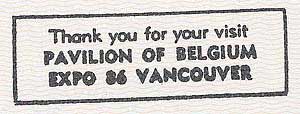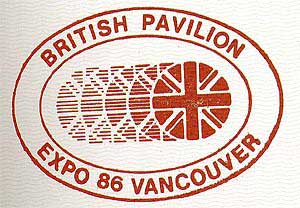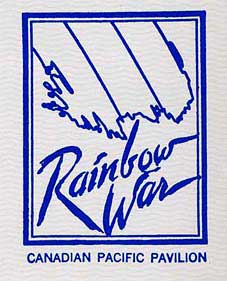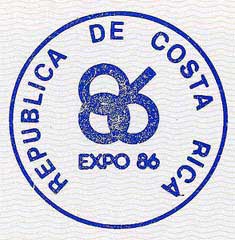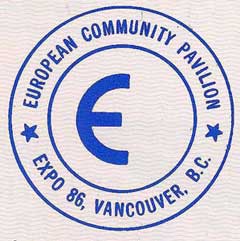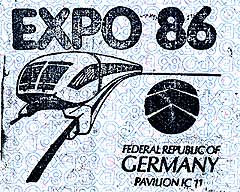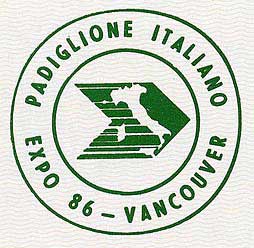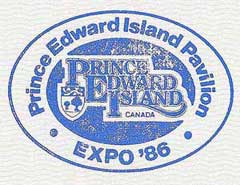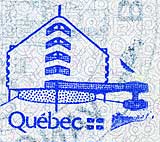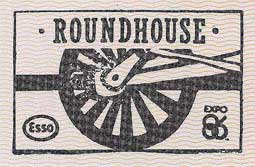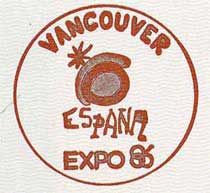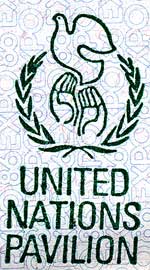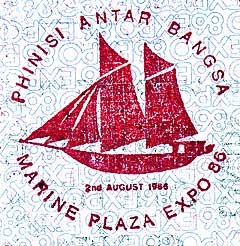 |
|
Air Canada All aboard the Lockheed L-10A, for a flight into Air Canada's 50-year history. The pavilion literally was built around the original aircraft that made the first flight by Trans-Canada Air Lines from Vancouver to Seattle in 1937. Visitors seemed to be seated on the aircraft's back as they watched a 15-minute kaaleidoscope of 16,000 slides. A bit heavy on airport goodbyes. Surprisingly, it's the historic shots of people like Elvis Presley and Pierre Trudeau flying on older airplanes, along with an excellent original soundtrack, that made this pavilion memorable. |
Alberta Visitors couldn't miss the exterior of this western prairie giant - a seven-story tower featuring an oil rig, grain elevator and water tower. Inside visitors were drawn into a sprawling Alberta landscape via miniature video images featuring typical Albertans at work and at play, and equally distinct hand-made representations of Alberta's contributions to transportation and communications. It was a little disappointing: there was not much made of the world-renowned Calgary Stampede. You could stroke the fur of a grizzly bear -hopefully this is the closest you'll ever get to one. There was a varied display of folk art from the Provincial Museum in Edmonton. At the "Grain Fall" exhibit, three prairie views reflected different seasons are presented by rotating wall panels. A slide/film presentation depicted a fast-paced chuck wagon race at a rodeo. Children loved climbing aboard the dinosaurs standing guard at the entrance. There was also a play structure inside the pavilion. There were two places to dine: the bistro has soup or salad for $2.75, entrees for $6.75 - 8.75, and desserts for $3.50 - 6.50; the dinner restaurant offered soup or salad for $3.00 - 4.50 and entrees from $15.00 - 19.50. |
|
Barbados It was billed as the communications centre of the Caibbean. But the few forms of communications they had on display were old-fashioned telephones - you could talk to taped messages of famous Barbadians - or a wall display of postage stamps. (The Barbados post office was established in 1852, the second oldest in the English speaking world.) Other than that, this pavilion was basically an advertisement for tourism, Barbados style. Books, stamps, clay model houses and pretty fish scale jewelry were for sale. |
|
|
Belgium Fans of Tintin, the famous Belgian detective, would feel instantly at home here. Others would merely feel confused. Visitors were greeted by a huge moonscape (Tintin, was he not, the first moon-walker back in 1953) and there was our hero talking to us, accompanied of course by his dog Snowy. Capt.Haddock and Prof. Caculus. Elsewhere, amid the model dredgers and articulated buses, you would learn that Belgium is the only country in the world that can be seen at night from outer space, because we were told, all of its street - including country lanes, are lit by street-lamps. "Be glad don't pay the hydro." You didn't miss displays of the first European train and a model of a vehicle that can switch from electric to diesel power. Children enjoyed the large display of Tin Tin, the comic book hero. Diamonds, lace, and irresistible Belgian chocolates are available here. |
Britain A make-believe British high street wound through this pavilion and parked along it were some of the best of the nation's developments in transportation - everything from a Rolls Royce to a rag-top sports car. Visitors also got a glimpse of the Concorde, a high-speed train, and watch a simulated rescue in a North Sea storm. But the hit of the pavilion was its pub designed to look like a little bit of old King's Lynn, Captain George Vancouver's Norfolk birthplace. See the 100,000th Rolls Royce and a car built for wheelchair users in the Land section. The loud noise heard about every three minutes accompanied a simulated sea rescue display. The restaurant, based on Kings Lynn - the home of George Vancouver - carried one of the largest assortments of beer ever provided in one restaurant.Shops: There was a gift shop near the exit. |
|
Canadian Pacific This was a MUST SEE for the kids and adults alike; it was one of the best shows at Expo. The two films are entertaining and visually exciting. Both shows owe a great deal to the "Wizard of Oz" and its images. You had to pay close attention to the constant "chatter" between the actors in the first show. The pace was quick and entertaining and great for kids. The second show, "Rainbow War", made a good point about human differences and offers a message for all ages. Tips: Stand in the center, far back from the stage in the first theatre. The second show looked equally good from anywhere in the theatre. |
Costa Rica Costa Rica's small coffee shop - inexpensive and featured marinated seafood - held more interest than the displays inside, all of which were commercial and aimed at attracting development to this small Central American Nation. A coffee merchant offered Costa Rican coffee for sale while a microlight manufacturer and the promoter of a three-wheeled car seeked investor interest. |
|
European Community The European Community Pavilion was pretty sterile - what with its video monitors and stationary exhibits. The only displays worth seeing had to be the elaborate one on the English Channel tunnel between Britain and France that would become a reality in 1993. |
|
|
France A full-size replica of the French train that travels at 240 kilometres an hour was the centre-piece of this pavilion. And every 18 minutes a sound and light show erupted in a blaze of neon around the train. It was a lively way to light up all the kinds of transportation in this pavilion, which was rather heavy on scale models. Visitors could get here by way of a new people-moving system called SK Soule that whisked passengers from a monorail station, across the European Plaza for 130 metres, and into the mezzanine level of the pavilion. There was no restaurant in the pavilion. The French bistro, "Le Toulouse-Lautrec" was located near the Korean pavilion. In addition, a list of Vancouver's French restaurants was provided.Shops: The La Belle France boutique at the edge of the European Plaza offered French crafts and, of course, perfume. |
Federal Republic of Germany The Germans had gone all out demonstrate the fair theme of transportation. There were classic old cars, including a 1927 open Mercedes-Benz in fire engine red, and the world's first motorbike, an 1885 Daimler with wooden wheels. Amongst many vehicles for the handicapped there was a voice-controlled wheelchair. The audio-visual combined the scenery of Germany with film of the sports and cultural stars of the Republic. The gift shop in the centre of the pavilion sells dolls, model cars, beer mugs and stamps. |
|
Holography Gallery This pavilion told you all you ever wanted to know about laser technology holography. Illustrative as well as informative, there were many exhibits of this art form. This display was designed by Canadian artist Michael Snow and was entitled "The Spectral Image". See the holograph of a woman which changes depending on your viewpoint. The pavilion was at the back of the Roundhouse. |
Hong Kong Film critics had described Hong Kong's slide and dance show as the "most exciting nine minutes at Expo." Half an hour after you saw it, you wanted to see it again. From the explosion of fireworks in the night sky over Hong Kong harbour to the bustle and neon of Wanchai, this was the next best thing to being there. The uniforms worn by the pavilion's hosts and hostesses were made of silk, yet looked like leather. Children. asked for a postcard, hand-drawn by a student in Hong Kong, to become a pen pal. |
|
Hungary A dramatic transportation contrast is provided in this pavilion with a 19th century coach and horses (replicas) a few yard away from a modern bus that had been sold to the province of Ontario. The pavilion was small but tried hard to show how well Hungarians perform in various sports and cultural activities. Tucked away in the back was the Budapest restaurant. The restaurant featured goulash and schnitzel. |
Italy Italy lived up to its billing as the country of style. Here all manner of stylish vehicles enticed visitors, including a 1950's sports car with fins higher than the roof. An Etruscan cart existes with a Ferrari Cabrolet. A stylish Italian speedboat seemed to leap from its display area. The rear wall presented an artistic testimony to athletes, horses and riders-muscle-power as the purest mode of transportation. |
|
Norway Norway was the only nation at Expo to have two pavilions. The main pavilion on the False Creek waterfront presents modern Norway - maritime technology from off-shore drilling to cargo ships. The imaginative display shows above and below water exhibits. There was also a film and a delightful restaurant overlooking the Marine Plaza. The second pavilion, Great Norwegian Explorers, was near Stadium Gate. It told the story of such famous men as Thor Heyerdahl of the Kon-Tiki raft expedition and Roland Amundsen, first man at the South Pole. The program "A Ticket to Norway" was a must see in order to better appreciate the displays. The Kvaerner wave power plant and the Condeep Statfjord displays were interesting examples of maritime technology. Shops: Trolls, dolls, pewter, cut-glass, sweaters and fur coats were featured. |
Nova Scotia Nova Scotia is Canada's second-smallest province and that may explain the brevity of its presentation at Expo. It took less than half an hour for visitors to stand through a multi-screen presentation of this maritime province's development as it chronicled Nova Scotia's leadership in ocean-related research and, at the same time, gave a travelogue of the people and places in the province. Shops: There was a shop shared by P.E.I. and Nova Scotia selling handknitted sweaters, model ships, books, and quilts. |
|
Prince Edward Island It may be the smallest and most densely populated of Canada's 10 provinces, but P.E.I. was one of the most charming exhibits at Expo. It gave weary visitors a chance to sit down and enjoy - a relaxing and continuous audio-visual display of the island's sights. It also paid tribute throughout to author Lucy Maud Montgomery, renowned for her Anne of Green Gables stories. There was a shop shared by P.E.I. and Nova Scotia featuring hand-knitted sweaters, model ships, books and quilts. |
Quebec What you saw was what you got, and in the Quebec pavilion there was no stationary exhibits. Instead, visitors were transported to the province via flashing video monitors and a circular film screen. Hockey buffs would appreciate the few shots of the Stanley Cup-winning Montreal Canadiens, but the presentation was mainly a celebration of Quebec, both high-tech industry and man-made splendor - urban and rural contrasts of the province that aren't often seen side-by-side. |
|
Roundhouse You were guaranteed a chuckle in this, one of Expo's least known theme pavilions. line-ups were short for an innovative look at failed inventions, talking cars and cartoon videos which could omly be viewed by focussing a telescope on the tiny monitors implanted in the pavilion ceiling. A 10-minute film of vintage inventions and inventors would keep you laughing until the final frame, which brang all mankind's inventiveness into sharp focus. |
Spain The Spanish were blunt: they told you point blank that one of the main reasons they were at Expo 86 86 was to promote their own world expo slated for Seville in 1992. The pavilion was one of the few at Expo to provide guided tours and the guides, witty and acerbic, were almost more entertaining than the pavilion itself; their verbal skills were so good that Expo actually recommended the pavilion for tours by blind people. The Don Quixote gift shop in the European Plaza sold fans, dolls, perfumes, soaps, jewelry and even swords. |
|
United Nations This was a truly inspiring pavilion, no matter what your politics. It's theme was Peace through Communications with visitors invited toeither write or film their messages for ppeace, or view films and videos laden with peace statements. Quotes from luminaries like Mother Teresa, Dag Hammarskjold and Albert Einstein adorned exhibits and there was even a tribute to Canada's late one-legged runner, Terry Fox. |
Marine Plaza Dominated by a towering steel Dream Ship, turquoise and hot pink, with dozens of stiff white sails, and iron sea monsters cavorting in its undulating, painted concrete wake. Nearby is the International Harbor, where traditional boats of every shape and age ride at anchor. One is a Thai fishing boat, painted in eye-filling folk patterns; another, a Pakistani dhow, similar to those on which Arab seamen once sailed the monsoon winds (See Aramco World, March-April 1974 and September-October 1981). On the wharf visitors can watch a team of Indonesian boat builders construct a native sailing vessel - a Pinisi - and in a small pool ashore, Canadian hobbyists demonstrate radio-controlled model boats. |
|
|
||



